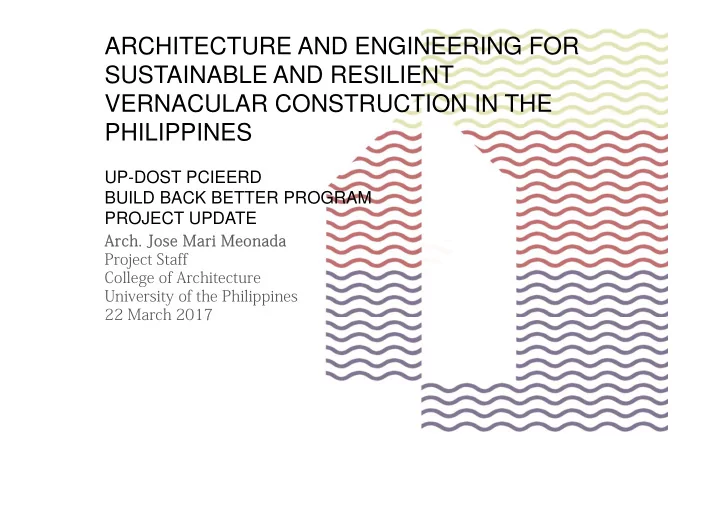

Arch. Jose Mari Meonada Project Staff College of Architecture University of the Philippines 22 March 2017 ARCHITECTURE AND ENGINEERING FOR SUSTAINABLE AND RESILIENT VERNACULAR CONSTRUCTION IN THE PHILIPPINES UP-DOST PCIEERD BUILD BACK BETTER PROGRAM PROJECT UPDATE
WHAT IS THE BUILD BACK BETTER PROGRAM? Department of Science & Technology as Monitoring Agency University of the Philippines – Diliman Overall Implementing Agency UPD College of Architecture as Program Lead & Project Study Implementer for Architectural Design UPD Institute of Civil Engineering as Project Study Implementer for Structural Engineering UPD School of Urban and Regional Planning As Project Study Implementer for Planning Program Background
PROJECT 1: Philippine Resilient to Earthquake and Severe Wind Loading Structural System and Construction Methodologies PROJECT 3: Systems Planning Guidelines for Disaster Response and Vernacular Architecture into Modern Building Adaptation of Traditional Wisdom from Selected The Architecture of Filipino Resilience: The PROJECT 2: Sensitive Environmental Planning Supply Chain and Delivery Management, and Risk- Rehabilitation of Communities and Localities via Project Components UP SURP UP CA UP ICE
DEVELOPMENT DESIGN OF CONSTRUCTION AND BUILDING MODELS RISK-ASSESSMENT & RISK-BASED PLANNING-ARCHITECTURE-ENGINEERING CONTROLS Integration Points MACRO PLANNING MIDDLE ARCHITECTURE MICRO ENGINEERING
ARCHITECTURE PROJECT GUIDELINES FOR DISASTER RESILIENT SITE PLANNING AND ARCHITECTURAL DESIGN DESIGN FOR BUILDING MODELS: HOUSING Project Output 1 2 PERMANENT SELF-BUILD
UP-DOST PCIEERD BUILD BACK BETTER PROGRAM OUTPUT 1: ARCHITECTURAL GUIDELINES FOR DISASTER RESILIENCE
REDUCING IMPACTS OF HAZARDS LEVELS OF ARCHITECTURAL INTERVENTION
IN REDUCING IMPACTS OF NATURAL HAZARDS In any project, it is ideal to be located in an area without or with minimal exposure to natural hazards. Interventions applied to the physical traits of an area (e.g. slope, grading, drainage, landscape). They can offer protection to structures, make evacuation more efficient, or more importantly even divert directions of hazards. Levels of Intervention LEVEL 1: SITE SELECTION LEVEL 2: SITE MODIFICATION
IN REDUCING IMPACTS OF NATURAL HAZARDS Enhancing the resilience of the building through interventions in building configuration (shape, spacing, layout), and proper building assembly. Levels of Intervention LEVEL 3: BUILDING DESIGN OR MODIFICATION
DIFFERENT AREAS = DIFFERENT HAZARDS Rain-Induced Flooding High-Velocity Winds Earthquakes Landslides Hazard-Specific Interventions
DIFFERENT HAZARDS = DIFFERENT AREAS = HAZARD-SPECIFIC INTERVENTIONS Blindly Adopting Identical Designs Across Different Areas in the Philippines Increases Disaster Risk
There is Solution Fits All One Size NO
INFORMED CREATIVITY AND DIVERSITY OF SOLUTIONS We can have similar hazard- specific performance goals, yet solutions can be diverse. Guided Innovation GUIDELINES OUTLINE PERFORMANCE GOALS.
SINGLE GUIDELINE = DIVERSE RESPONSIVE SOLUTIONS Guidelines aid towards the development of disaster-resilient design across many building types. Multiple Modalities
THE CASE OF DIVERSE REGIONAL ARCHITECTURE Traditional Filipino Wisdom
Recommend
More recommend